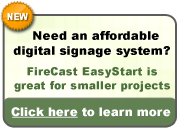Not sure if this thing technically qualifies as a kiosk, but it's a pretty neat idea nonetheless (whether or not its time has come is a matter for further discussion, of course). According to this press release/blurb thingy from Progressive Grocer:
Tags: kiosks, self-service, electronic coupons
Big Y here grew sales of merchandise on promotion an average of 71 percent during a yearlong pilot of a new paperless in-store coupon system.I've been trying to find out more about the Ez-Pic system, but their homepage is a bit spammy and lacking information. I'm not too sure how it differs from simply having a sale price for the advertised product, as it's unclear whether the customer has to do anything (or not) to redeem the "electronic coupon" at checkout.
The solution, called Ez-Pic from Chicago-based Unicous Marketing Inc., is a paperless coupon advertised on retail store shelves and redeemed electronically at checkout. According to the vendor, data supplied for the study was made available by progressive Grocer parent The Nielson Co. and select manufacturers which used the Ez-Pic system in the pilot.
"Ez-Pic is a seamless value, with no aggravation for our customers," said Phil Schneider, v.p. of center store for Big Y. "Plus, there are no additional cost to us."
Unicous said Big Y benefitted through a higher volume of promotional sales and cost efficiencies related to reduced coupon handling time at checkout and on the back-end using traditional coupon clearing house processes.
Tags: kiosks, self-service, electronic coupons


 Subscribe to this blog
Subscribe to this blog
6 comments:
To see how it works, go to this site: http://www.ez-pic.com/devpub/howitworks.html
NOT this site:
http://ez-pic.paperlesscoupon.com/2007/02/14/putting-the-brakes-on-coupon-fraud.aspx
Thanks! That clears it up a lot. I didn't even realize it was a Unicous product.
How is this different than a traditional discount advertised with a sign at the POP?
I think the primary difference is that with this system, the coupon is "redeemed" by the retailer, and the manufacturer (who has sanctioned the promotion) will pay them for it.
With a sale or traditional discount, the retailer is usually the one that's responsible for lowering the price (and makes less money on the sale of the item).
Bill, that's simply not the case. Promotions are driven by the manufacturer, whether they are coupons, cents-off, etc.
The retailer is reimbursed typically through promotion allowances, either purchasing discounts or rebates.
The only thing I can think is that in the manufacturer is interested because it can see discrete redemptions.
Regardless, this must be a manufacturer driven program because the mechanism for the consumer is no different than a traditional discount.
Or maybe it is simply a company in an industry that is not expanding and is trying to find ways to get revenue.
I read it here and there. From beginning till end and from end till beginning. And I really see only one conlcusion this DOES NOT differ from normal sales offer.
As i understand paperless coupon works like this you take product that has offer lets say 3 for price of 2 and pay it at checkout. Whereas normal discount you just take 3 for price of 2 and pay it at checkout. Difference you just think that on first option it could have been with coupon, but hey you just didnt have to use it.
Post a Comment